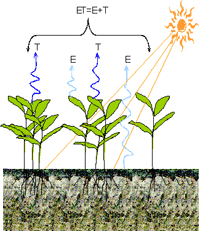Agricultural Research Division of IANR

West Central Research and Extension Center, North Platte
Date of this Version
12-2009
Abstract
In a 2-year field study, we quantified lateral root growth patterns and soil water depletion dynamics in the invasive annual Centaurea solstitialis and two native perennials, Elymus glaucus and Grindelia camporum. Centaurea solstitialis produced lateral roots most actively from early April to mid-June, during the late rosette to spiny seedhead stage while both root growth and water depletion were completed before flowering. In the wet year, roots were evenly distributed throughout the soil profile to 180 cm deep. Lack of deep soil moisture recharge in the second year restricted root distribution to shallow soil depths (< 60 cm). In contrast to C. solstitialis, living roots of the native perennials persisted throughout the year. Elymus glaucus roots were most abundant (47% of total roots) in the upper soil profile (≤ 60 cm) in the wet year, but most abundant (55%) in the lower profile (≥ 150 cm) in the dry year. However, the distribution of G. camporum roots was comparable between the 2 years. This indicates that in years with little to no deep soil moisture recharge, C. solstitialis roots are distributed in the shallow soil profile similar to annual grasses, whereas in wetter years it is similar to deep-rooted perennial species. We also show that C. solstitialis impacts grassland communities by depleting soil moisture during the short period of lateral root growth from the late rosette to the spiny stage. Therefore, control of C. solstitialis early in the season is critical during native plant restoration where success depends upon available soil moisture.


Comments
Published in Restoration Ecology (Early View) December 29, 2009; doi: 10.1111/j.1526-100X.2009.00624.x Copyright © 2009 Society for Ecological Restoration International. Used by permission.